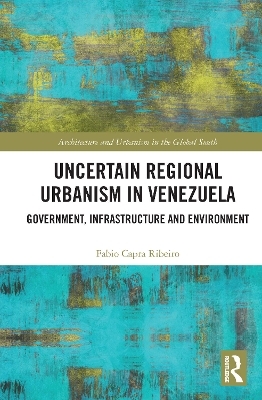
Uncertain Regional Urbanism in Venezuela
Routledge (Verlag)
978-0-367-51085-5 (ISBN)
- Titel z.Zt. nicht lieferbar
- Versandkostenfrei
- Auch auf Rechnung
- Artikel merken
Uncertain Regional Urbanism in Venezuela explores the changes cities face when they become metropolises, forming expanding regions which create both potential and problems within settlements. To do so, it focuses on three metropolitan areas located in Venezuela’s Center-North region: Caracas, Maracay and Valencia, designated as "Camava."
Considering three core topics, government and territorial administration, infrastructure and environment, as well as looking at the reciprocal impact, this book describes and analyzes the determinant variables that characterize the phenomenon of regional urbanization in this area and in the wider Global South. It includes documentary research, semi-structured interviews and Delphi methodology, involving a total of forty experts from different disciplines to build a comprehensive outlook on the situation.
This book presents a broader understanding of the region to encourage a more sustainable and knowledge-based development plan, moving away from the exploitation of natural resources, with six future-oriented scenarios to consider. This is a much-needed study in the urban regions of Venezuela, which will be of interest to academics and researchers in Latin American studies, the Global South, architecture and planning.
Fabio Capra Ribeiro is Associate Professor at the Universidad Central de Venezuela. He is a practicing architect, with a Master’s degree in Science in Architectural Design and a PhD in Urbanism and fifteen years working on social, spatial, and environmental justice, particularly in the degradation of the contemporary city through the study of integration spaces and boundary conditions. His website address is www.capraribeiro.com.
Introduction
Chapter 1. Mapping the complexity of a poorly studied case
The urban region Caracas-Maracay-Valencia
Three attempts to deny the reality
A compound perspective to approach a complex case
Knowledge and foresight
The difficulties to investigate in Venezuela nowadays
Strategies to operate in a harsh context
Chapter 2. The formation of the main urban region of Venezuela
Camava definitions: what has been said
Strategic position, natural conditions and sea proximity
First concentration, centuries of an archipelago country
Second concentration, from one caudillo to another
Third concentration, more than ever
Chapter 3. Three factors to understand a harsh reality
Recently dead metropolitan government
Once decent infrastructure
No place for nature
Nothing less, nothing more, just Camava
Chapter 4. Agreement on the complex future
Not-so-uncertain Delphi results
Incoming transversal conditions
Chapter 5. Camava’s future expectation
Five scenarios for Camava
Looking through the scenarios
Chapter 6. Synthesizing strengths and weaknesses
A more honest future
Final thoughts
| Erscheinungsdatum | 22.12.2022 |
|---|---|
| Reihe/Serie | Architecture and Urbanism in the Global South |
| Zusatzinfo | 17 Tables, black and white; 6 Line drawings, black and white; 23 Halftones, black and white; 29 Illustrations, black and white |
| Verlagsort | London |
| Sprache | englisch |
| Maße | 156 x 234 mm |
| Gewicht | 280 g |
| Themenwelt | Naturwissenschaften ► Biologie ► Ökologie / Naturschutz |
| Naturwissenschaften ► Geowissenschaften ► Geografie / Kartografie | |
| Sozialwissenschaften ► Ethnologie | |
| Sozialwissenschaften ► Soziologie ► Spezielle Soziologien | |
| Technik ► Architektur | |
| ISBN-10 | 0-367-51085-5 / 0367510855 |
| ISBN-13 | 978-0-367-51085-5 / 9780367510855 |
| Zustand | Neuware |
| Haben Sie eine Frage zum Produkt? |
aus dem Bereich


